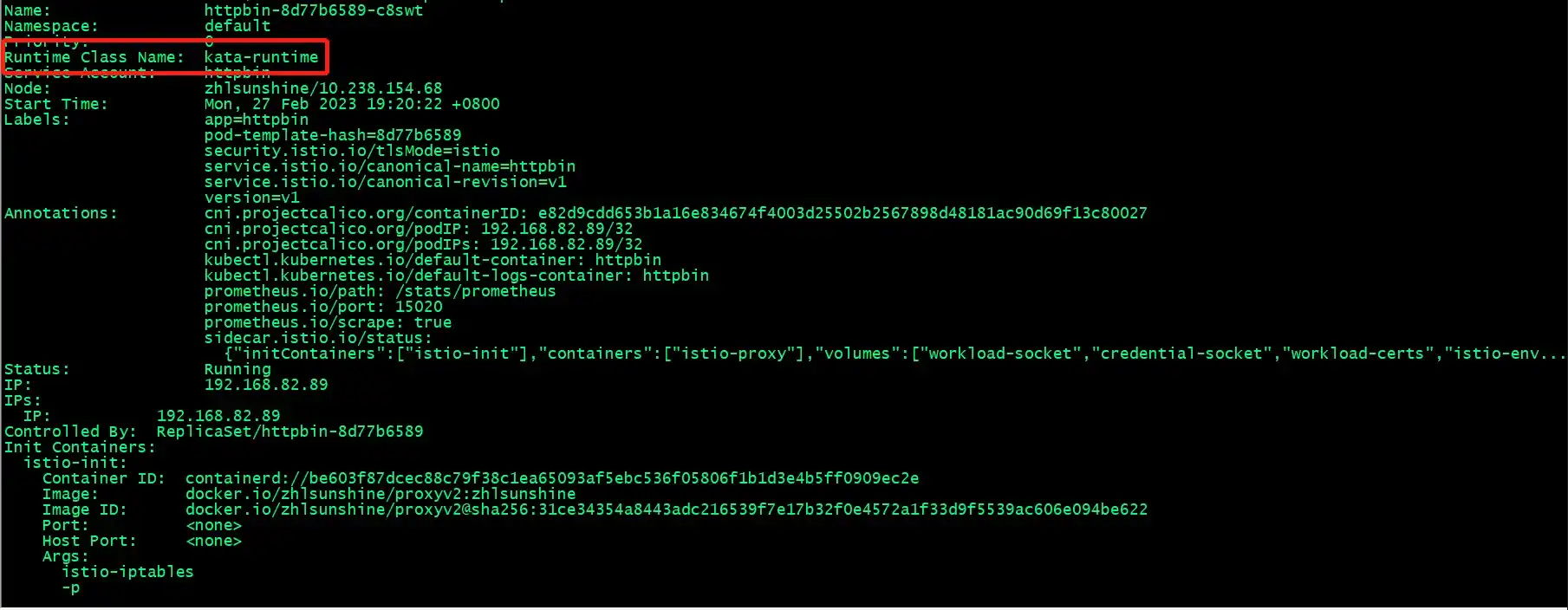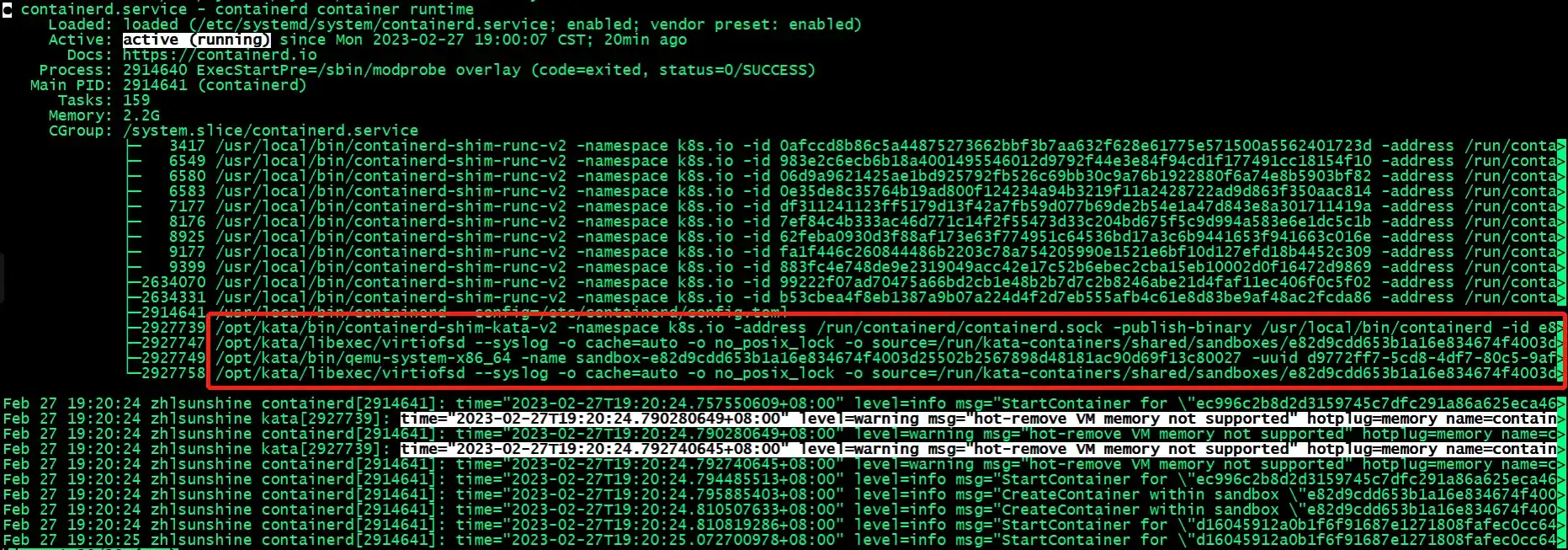Inject Workloads with Kata Containers in Istio
Written by Steve(Huailong) Zhang
Kata Containers, which is a merger of two existing open source projects - Intel Clear Containers and Hyper runV, is an open source project and community working to build a standard implementation of lightweight Virtual Machines (VMs) that feel and perform like containers, but provide the workload isolation and security advantages of VMs.
Based on the definition above, it’s natural for me to think about how to achieve the Kata Containers as one of multiple container runtimes in Istio to inject the workload. The good news is that I successfully deployed it in my environment, and this blog will introduce what benefits we can get from Kata Containers and how to deploy it.
What’s the benefit of using Kata Containers?
Kata Containers is designed to provide greater isolation between containers while still maintaining the performance and efficiency provided by other runtimes. There is one critical difference for Kata Containers to be a special container runtime: Kata runtime enforces a deeper level of isolation between containers than other runtimes by following below two points:
- Each pod runs its own kernel instead of sharing the host system’s kernel with the host and other containers using
cgroupsin Kata - Kata Containers can take advantage of security features provided by hardware-level virtualization (meaning virtualization that is built into CPUs and made available using VT extensions)
However, it’s different from common virtual machines to take a minute or two for starting and wasting a fair amount of hardware resources on establishing container isolation, Kata starts just as fast and consumes resources just as efficiently as other containers. The containers become more secure with the lowest cost:

How to deploy workload injection with Kata Containers in Istio:
Environment Prepared
- Containerd 1.5.6
- Kata Runtime v3.0.2
- Kubernetes Cluster via kubeadm (do not use Kind) v1.23
- Istio v1.17-dev
Install Kata Containers
There are 6 methods to install Kata Containers via the installation guides found here and here. I have tried two of them (Using snap and Manual), and I recommend the manual method because it’s mess to me when using snap. So let’s get into Manual guides.
Key highlights:
-
After untarring the Kata Containers package, move all files into
/opt/kataor/$HOME/opt/katadirectory, depending on your system & user. Once complete, there should be four files —bin,libexec,runtime-rs, andshareunder/opt/kata. -
Copy
/opt/kata/share/defaults/kata-containers/configuration.tomlinto/etc/kata-containers/configuration.tomlNote: Please choose the corrected configuration file for you, and create the/etc/kata-containersdirectory if it does not exist. -
Create 5 symbolic links (symlinks) for Kata Containers installation files by following commands:
$ ln -s /opt/kata/bin/kata-runtime /usr/local/bin/kata-runtime
$ ln -s /opt/kata/bin/containerd-shim-kata-v2 /usr/local/bin/containerd-shim-kata-v2
$ ln -s /opt/kata/bin/kata-monitor /usr/local/bin/kata-monitor
$ ln -s /opt/kata/bin/kata-collect-data.sh /usr/local/bin/kata-collect-data.sh
$ ln -s /opt/kata/bin/qemu-system-x86_64 /usr/local/bin/qemu-system-x86_64
Please refer to Kata Containers installation guides for more detail.
Configure Containerd correctly
This content is included in Configuring Containerd to use Kata Containers, however, I just want to simplify the plugins configuration for Containerd by using RuntimeClass as shown below:
[plugins."io.containerd.grpc.v1.cri".containerd]
default_runtime_name = "runc"
[plugins."io.containerd.grpc.v1.cri".containerd.runtimes]
[plugins."io.containerd.grpc.v1.cri".containerd.runtimes.kata]
runtime_type = "io.containerd.kata.v2"
privileged_without_host_devices = true
[plugins."io.containerd.grpc.v1.cri".containerd.runtimes.kata.options]
ConfigPath = "/opt/kata/share/defaults/kata-containers/configuration.toml"
[plugins."io.containerd.grpc.v1.cri".containerd.runtimes.runc]
runtime_type = "io.containerd.runc.v2"
[plugins."io.containerd.grpc.v1.cri".containerd.runtimes.runc.options]
SystemdCgroup = true
In this configuration, I define two types of runtime: runc and kata and default by runc.
Note: If Containerd configuation is changed, you will need to reload & restart services using the commands sudo systemctl daemon-reload and sudo systemctl restart containerd.
Configure kubelet correctly
This content is included in Configure kubelet to use Kata Containers, the configuration file /etc/systemd/system/kubelet.service.d/10-kubeadm.conf is below:
$ Environment="KUBELET_EXTRA_ARGS= — container-runtime=remote — container-runtime-endpoint=unix:///run/containerd/containerd.sock — cgroup-driver=systemd"
Inject workloads with Kata Containers in Istio
Generally, there should be no difference when installing k8s cluster and Istio, demonstrated below as I install cluster via kubeadm command:
$ kubeadm init — cri-socket=unix:///run/containerd/containerd.sock — pod-network-cidr=10.244.0.0/16 — v=5 — ignore-preflight-errors=all`
Then install Istio via istioctl command istioctl install -y
Based on the Containerd configuration from before, runc is the default container runtime, which can be verified with the command: $ sudo systemctl status containerd

I use RuntimeClass to launch the Kata Containers, using the yaml file kata-runtimeclass.yaml below:
apiVersion: node.k8s.io/v1
kind: RuntimeClass
metadata:
name: kata-runtime
handler: kata
The RuntimeClass CustomResource (CR) name is kata-runtime and the handler field is specified as kata. Create this CR by command:
$ kubectl apply -f kata-runtimeclass.yaml
I use httpbin as an example by using httpbin.yaml, however, there should be a little change for it, and the final yaml is below:
apiVersion: v1
kind: ServiceAccount
metadata:
name: httpbin
- -
apiVersion: v1
kind: Service
metadata:
name: httpbin
labels:
app: httpbin
service: httpbin
spec:
ports:
- name: http
port: 8000
targetPort: 80
selector:
app: httpbin
- -
apiVersion: apps/v1
kind: Deployment
metadata:
name: httpbin
spec:
replicas: 1
selector:
matchLabels:
app: httpbin
version: v1
template:
metadata:
labels:
app: httpbin
version: v1
spec:
runtimeClassName: kata-runtime
serviceAccountName: httpbin
containers:
- image: docker.io/kennethreitz/httpbin
imagePullPolicy: IfNotPresent
name: httpbin
ports:
- containerPort: 80
Be mindful of the presence of an extra runtimeClassName: kata-runtime field in the containers section of the Deployment. I have already defined the RuntimeClass CR as kata-runtime. Another important note is that the httpbin ServiceAccount is required, because Kata Containers needs a cluster role.
Now it is time to deploy this service using the following command:
$ kubectl apply -f <(istioctl kube-inject -f httpbin-hsm.yaml)
Verify the workload as demonstrated below:

There should be a new Runtime Class Name property, as is shown in the above red rectangle box.

Besides the Containerd containerd-shim-runc-v2, there are also other processes for Kata Containers shown in the above red rectangle box, such as containerd-shim-kata-v2, virtiofsd and qemu-system-x86_64. This is because I deploy a service which requires Kata Containers to inject in Cluster.
Conclusion
- Basically, there are not many differences for using Kata Containers with other generic container runtimes in Istio from my use case: deploy
httpbinandbookinfo, but we still need to verify more other things, such as network CNI situations, Istio CNI enablement and so on. - There may be multiple container runtimes according to different requirements in Istio later in the same environment at the same time, and we need to be aware of this.
About the author
Steve(Huailong) Zhang has worked for Alcatel-Lucent, Baidu and IBM to engage in cloud computing research and development. Huailong is currently working for Intel China as a cloud-native software engineer, focusing on cloud-native service mesh technical fields. He is an Istio maintainer and Linkerd developer. He also leads and participates in Istio’s Dual Stack feature support work (to be officially released in Istio 1.17).